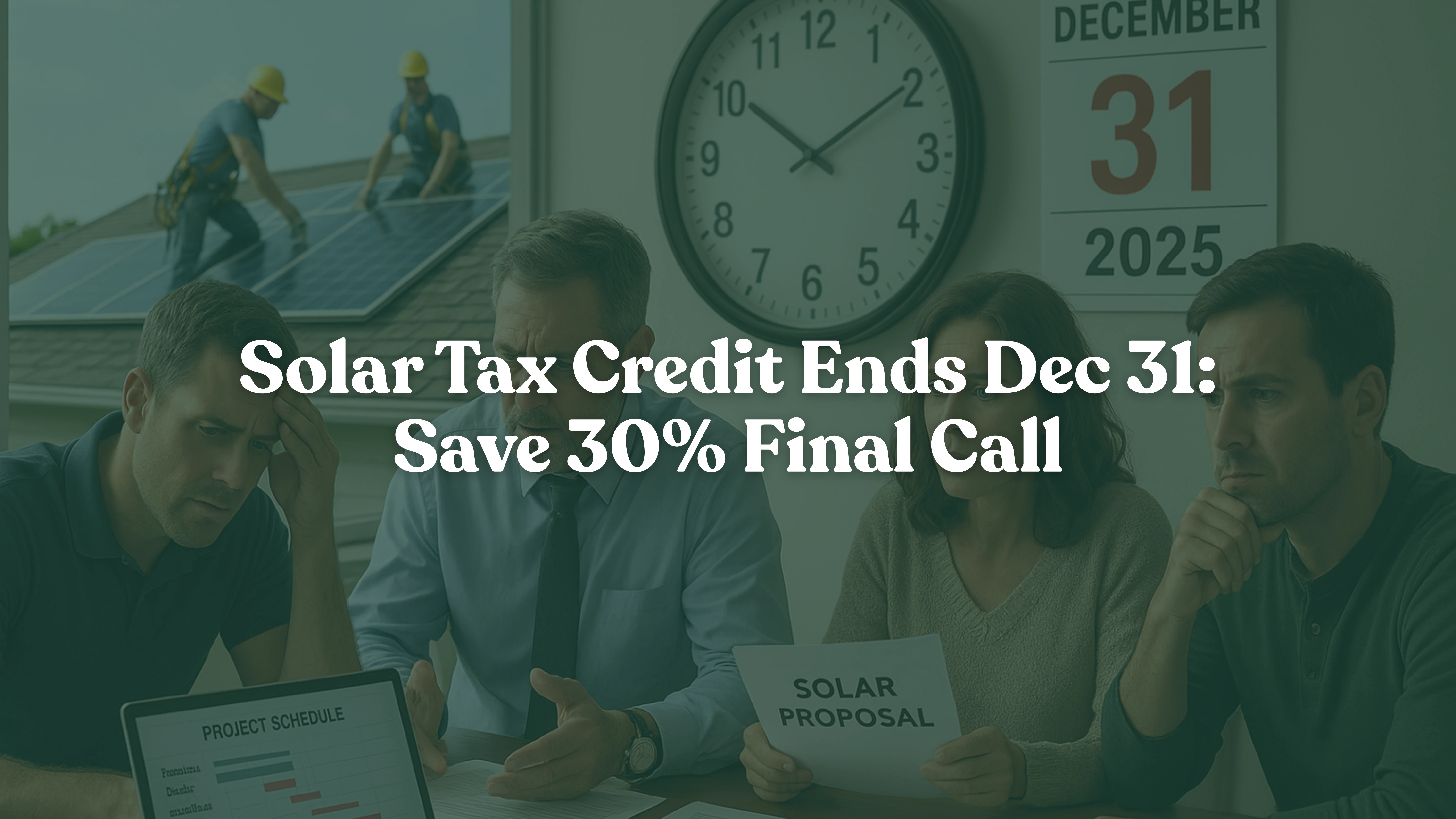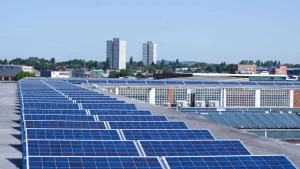One Big Beautiful Bill Solar Kills Credits: Reshape Your Business?

December 31 Deadline: How the One Big Beautiful Bill Is Reshaping Your Solar Pipeline (Act Now or Lose 30%)
Quick Answer: What Is the One Big Beautiful Bill Solar Impact on Solar?
The One Big Beautiful Bill Solar (OBBB) terminates the 30% residential solar tax credit on December 31, 2025, requiring homeowners to have systems installed by this date to qualify. Commercial projects must start construction by July 4, 2026, or be completed by December 31, 2027.
The solar industry—from major players like Sunrun and Tesla to local installers across California, Texas, and Florida—faces its biggest policy shift since the Inflation Reduction Act. If you’re wondering whether it’s too late to go solar, the answer is no—but you need to act immediately.
Critical Deadlines: A Timeline Every Solar Professional Needs
When Do Solar Tax Credits End? (The Complete One Big Beautiful Bill Solar Breakdown)
| Credit Type | Deadline | Impact | Action Required |
|---|---|---|---|
| Residential (25D) | Dec 31, 2025 | Complete termination | Install by deadline |
| Commercial Start | July 4, 2026 | Construction must begin | Secure permits now |
| Commercial Completion | Dec 31, 2027 | Must be operational | Plan 18-month timeline |
| Energy Storage | 2034 phaseout begins | Maintains full credit | Pair with solar projects |
For California Solar Installers: With the state processing approximately 40% of national installations, California’s market faces unique pressures. Los Angeles County alone needs to complete an estimated 15,000 installations before December 31.
For Texas EPCs: Houston and Dallas markets, which saw 35% growth in Q2 2025 according to SEIA data, must navigate both deadline pressure and grid interconnection delays.
For Florida Contractors: Miami-Dade and Broward counties report 60-day permitting backlogs, making October contracts essential for December completion.
State-by-State Solar Market Analysis Post- One Big Beautiful Bill Solar
High-Impact States Facing Immediate Changes:
California (Solar market leader with 18 GW installed capacity)
- Current status: 45,000 pending residential installations
- Key markets: San Diego, Los Angeles, San Francisco Bay Area
- State response: CPUC considering expanded NEM 3.0 credits
- Local insight: “California installers are seeing 3x normal inquiry volume,” reports CALSSA (California Solar & Storage Association)

Texas (Second-largest solar market, 15 GW capacity)
- Current status: 28,000 projects in pipeline
- Key markets: Houston, Dallas-Fort Worth, Austin, San Antonio
- State response: ERCOT fast-tracking interconnection approvals
- Local challenge: Summer installation delays due to heat restrictions

Florida (Third-largest residential market, 12 GW capacity)
- Current status: 22,000 installations targeted for Q4 2025
- Key markets: Miami, Tampa, Orlando, Jacksonville
- State response: Governor considering state-level incentives
- Hurricane consideration: September-November weather windows critical

Arizona, Nevada, New York, Massachusetts – Each implementing emergency measures to process permit backlogs, with Massachusetts offering additional state credits to offset federal losses.
Understanding FEOC: The Supply Chain Revolution
What Qualifies as FEOC-Compliant Equipment?
Starting January 2026, your equipment choices narrow significantly. Here’s what major manufacturers mean for your projects:
FEOC-Compliant Manufacturers:
- First Solar (US – Tempe, Arizona)
- Qcells (South Korea, with Georgia manufacturing)
- REC Group (Norway/Singapore)
- Silfab Solar (Canada/US facilities)
- Mission Solar (San Antonio, Texas)
At-Risk Suppliers Requiring Verification:
- JA Solar (Chinese-owned)
- Trina Solar (Chinese-owned)
- Canadian Solar (Despite name, Chinese-controlled)
- LONGi Solar (Chinese manufacturer)
According to analysis from Sidley Austin LLP, “roughly 17 GW of Chinese-affiliated solar PV module manufacturing capacity in the U.S.” exists, but ownership structures may disqualify them from credits.
Installation Strategies: Your 90-Day Action Plan Before One Big Beautiful Bill Solar
For Residential Solar Companies:
Immediate Actions (September 2025):
- Contact every lead from the past 12 months about deadline urgency
- Secure equipment inventory for 120% of projected Q4 installations
- Partner with regional installers to share crews and inventory
- Implement “deadline pricing” with urgency discounts for September signings

Customer Communication Scripts That Work: “The federal government’s One Big Beautiful Bill means the 30% tax credit—worth an average $6,000 on a typical system—ends December 31. With installation timelines, homeowners who don’t sign by October 31 risk losing these savings forever.”
For Commercial EPCs:
Project Acceleration Tactics:
- File all interconnection applications by September 30
- Document construction start with time-stamped photos and notarized affidavits
- Establish multiple supply chain sources across different countries
- Consider partial installations to meet “physical work” requirements

Key Insight from Norton Rose Fulbright: “Projects that begin construction in 2025 would need to be placed in service before the end of 2029,” giving commercial developers a longer runway than residential.
The Economics: Making Solar Work Without Federal Credits
2025 vs. 2026 Cost Comparison:
Typical 7 kW Residential System:
- 2025 with 30% credit: $21,000 gross, $14,700 net
- 2026 without credit: $21,000 gross, $21,000 net
- Difference: $6,300 immediate loss in savings
Commercial 500 kW Installation:
- 2025 with ITC: $500,000 gross, $350,000 net
- 2026 without ITC: $500,000 gross, $500,000 net
- Additional FEOC compliance costs: +15-20%
State Incentives Partially Filling the Gap:
New York: Maintains $0.20/watt state rebate through NY-Sun program Massachusetts: SMART program offers $0.15-0.30/watt depending on project size California: SGIP battery incentives continue at $200-$1,000/kWh Illinois: Adjustable Block Program maintains commercial incentives.
The One Big Beautiful Bill Solar: Expert Insights and Industry Perspectives
Abigail Ross Hopper, SEIA President & CEO, states: “The U.S. solar industry installed nearly 18 gigawatts of new capacity in the first half of 2025, but the OBBB creates unprecedented urgency for the remainder of the year.”
Keith Martin, Norton Rose Fulbright Partner, advises: “Developers should consider diversifying their safe-harbor strategies for a ‘multi-prong’ approach, and prepare for any outcome from Treasury guidance.”
Bryen Alperin, Foss & Company, warns: “If the homeowner pays for the installation in 2025, they could lock in the credit, even if the system is placed in service later—but documentation is critical.”
Regional Market Intelligence
Northeast Corridor Dynamics:
Boston to Washington D.C. markets face unique challenges with winter installation restrictions. Massachusetts installers report booking into February already, while New Jersey’s incentive program sees 400% application increases.
Southwest Desert Markets:
Phoenix and Las Vegas benefit from year-round installation weather but face module degradation concerns with potential non-tier-1 FEOC-compliant alternatives. Local utilities like APS and NV Energy expedite interconnection processes.
Southeast Emerging Markets:
Atlanta, Charlotte, and Nashville represent high-growth opportunities as Duke Energy and Southern Company expand solar programs. These markets show 50% year-over-year growth despite policy uncertainty.
Action Items Checklist for Solar Professionals
This Week:
- Audit current pipeline for deadline feasibility
- Contact top 100 prospects about deadline urgency
- Secure Q4 equipment deposits with suppliers
- Review contracts for force majeure clauses
This Month:
- Finalize all October installation contracts
- Establish backup equipment suppliers
- Hire and train additional installation crews
- Create customer communication campaigns
Before December 31:
- Complete all residential installations
- Document commercial construction starts
- File all tax credit certifications
- Prepare for 2026 market transition
Move Fast, But Build Right with Energyscape Renewables: Before One Big Beautiful Bill Solar.
The One Big Beautiful Bill and FEOC rules make 2025 a high-urgency year: projects that miss documentation, compliant equipment choices, or fast permitting risk losing incentives and market share.
Energyscape Renewables helps installers and EPCs turn that urgency into opportunity by delivering end-to-end solar engineering, permit-ready plansets, fast PE stamping, interconnection/PTO support, and storage-ready designs—so your projects clear AHJs and utilities faster and more reliably.
Paired with Sunscape’s site-survey and CRM tools, your teams capture accurate site data, automate workflows, and keep timelines tight during the Q4 rush—reducing delays and protecting your customers’ credits.
Short version: act now before the one big beautiful bill solar passes, standardize your designs and documentation, and let Energyscape + Sunscape be the single partner that keeps your projects compliant, fast, and profitable.
Would you like this tightened into a one-line CTA for email or LinkedIn?
FAQ: Your Most Pressing One Big Beautiful Bill Solar Questions Answered
Q: Can I still get the 30% tax credit if I sign a contract in November 2025?
A: Signing in November is extremely risky. Systems must be fully installed and operational by December 31, 2025. With typical 2-4 month installation timelines and year-end backlogs, contracts signed after October 31 have less than 50% chance of completion by deadline, based on industry analysis from Norton Rose Fulbright.
Q: What are FEOC restrictions and how do they affect my solar project?
A: Foreign Entity of Concern (FEOC) restrictions beginning January 1, 2026, disqualify projects using Chinese-manufactured equipment from tax credits. This affects approximately 83% of current solar panel supply chains, according to Wood Mackenzie research. Companies like Canadian Solar, JinkoSolar, and LONGi modules may become ineligible for projects starting after 2025.
Q: Do solar batteries still qualify for credits after 2025?
A: Yes, energy storage maintains full tax credit eligibility through 2034 when paired with qualifying solar installations. Enphase, Tesla Powerwall, and LG Chem systems remain eligible, creating opportunities for solar-plus-storage projects even after solar-only credits expire.
Q: How does “beginning of construction” work for commercial projects?
A: Projects qualify by either starting physical work of significant nature or incurring 5% of total costs. However, President Trump’s July 7 executive order directed Treasury Secretary Janet Yellen’s successor to tighten these rules by August 18, 2025, potentially eliminating the 5% safe harbor option.

sjayakanth@energyscaperenewables.com